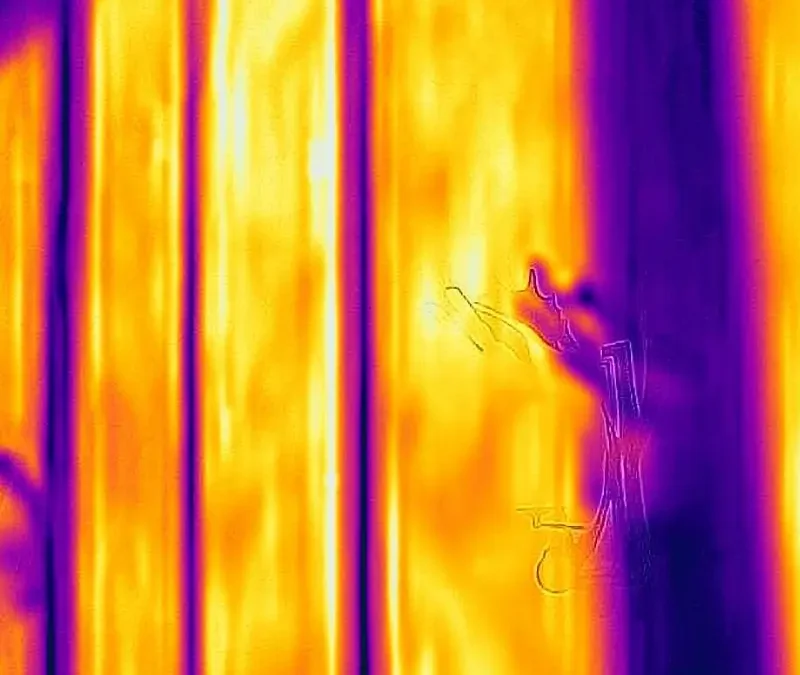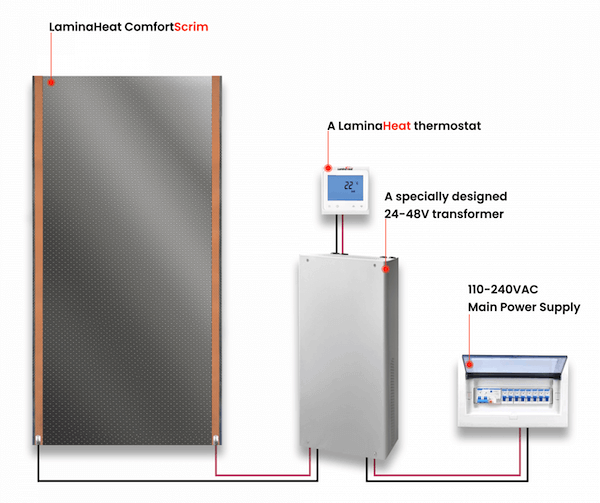Are you looking to create a warm and cosy environment in your home with a modern touch? Understanding the best heating solutions for your space gives you an upper hand; hence it’s time to eliminate those outdated, expensive, and inefficient traditional heaters. Welcome to our all-inclusive guide on Wall or Ceiling Heating: Installation, Benefits, and Cost Comparison. This post delves into everything you need to know about infrared heating installations; from how they work, their unique benefits, to a comprehensive cost analysis. Your path to achieving ultimate comfort starts now!
Table of Contents
Wall Heating vs Ceiling Heating
Benefits of Wall and Ceiling Heating
Cost Comparison of Wall and Ceiling Heating
Wall Heating vs Ceiling Heating
When it comes to choosing between wall heating and ceiling heating, there are several factors to consider. Let’s explore the key differences and benefits of each option.
Wall heating involves installing heating elements either within the walls of a room, typically behind a layer of drywall or plaster or directly mounting heating panels onto the walls. This allows the heat to be emitted from the walls, providing a warm and comfortable environment. Wall heating is particularly effective in rooms with high ceilings as the warmth can reach lower levels of the space more efficiently. An added benefit of the heated walls is that you can sit with your back against them increasing comfort even more!
On the other hand, ceiling heating operates by installing heating elements in the ceiling, allowing heat to radiate downward. This creates an evenly distributed heat source throughout the room, similar to the warmth we feel from the sun. Such radiant heat provides a cosy and comfortable atmosphere without any forced air movement or noise.
Both wall heating and ceiling heating utilize infrared heating, which differs from conventional radiator-based systems that rely on convection to warm a room. Infrared heat works by emitting warmth directly to objects and people in its path rather than warming the air through convective currents. This feature brings a multitude of benefits, from maintaining a better humidity level in the space, to reducing circulation of dust particles, and even creating a more lasting even warmth!
Now that we have explored the two options at a high level let us delve into their characteristics and efficiency in greater detail.
Characteristics and Efficiency
When it comes to characteristics, wall heating offers a unique advantage as it can act as both a heating solution and a thermal storage system. The structure of most walls allow for efficient heat retention and gradual release over time, even after the heating system is switched off. This characteristic ensures that rooms stay warm for longer periods while reducing energy consumption in the long run. However, it should be noted that this is dependent on the specific wall construction. If there is no inner or outer wall insulation included these walls can actually serve as massive heat sinks! So as always, it’s highly recommended to allow a specialist to accurately assess the space and provide an optimal heating plan.
In contrast, ceiling heating focuses on delivering consistent infrared heat from above. This uniform distribution of heat better eliminates temperature asymmetries, providing a comfortable and cozy environment throughout the entire room.
In terms of efficiency, both wall heating and ceiling heating have their advantages. Wall heating benefits from its proximity to the floor level, allowing it to warm up the room faster and potentially reducing energy consumption (especially so in smaller rooms). However, ceiling heating has lower flow temperatures compared to wall heating, making it a more energy-efficient choice in the long term. Ceiling heating also offers greater flexibility in interior design, as there are no visible radiators or other heating elements and often wall space is limited due to the desire to hang up items on the walls.
Imagine a scenario where you have a high-ceiling living room. In this scenario it may be the case that wall heating is ideal so as to ensure that the lower levels of the space receive sufficient warmth, especially if combined with floor heating, whereas if only ceiling heating was chosen in this space then the total installed power may need to be increased to account for the high ceilings.
Choosing between wall heating and ceiling heating is like selecting between two different flavors of ice cream – they both serve the same purpose of keeping your room warm but offer distinct characteristics that may appeal to different preferences and requirements.
While wall heating is advantageous for its thermal retention capabilities and fast warming potential, ceiling heating excels in energy efficiency and uniform heat distribution. Ultimately, the choice depends on factors such as room layout, personal preferences, and budget considerations.
Now that we have explored the characteristics and efficiency of both wall heating and ceiling heating, let’s delve into their suitability and usage cases to understand which option might be best for your specific needs.
Benefits of Wall and Ceiling Heating
Both wall and ceiling heating systems bring unique advantages that contribute to overall comfort and energy efficiency in a space. Let’s take a closer look at these benefits:
Comfort Benefits:
- Even Heat Distribution: Wall and ceiling heating systems provide infrared heat, which ensures even heat distribution throughout a room (as long as it’s properly designed). This creates a more comfortable environment by minimizing cold spots and temperature variations, and avoiding drying out the air.
- Silent Operation: Unlike traditional radiator systems that rely on hot air convection, wall and ceiling heating operate silently as they emit infrared heat. This absence of forced air circulation helps reduce noise levels in your living or working space.
- Invisible Heating Solution: Since wall and ceiling heating systems are integrated into the structure, they remain completely hidden from view. This offers greater flexibility in interior design as it eliminates the need for visible radiators or bulky heating units.
- Allergy-Friendly: Wall and ceiling heating systems are beneficial for individuals who suffer from dust or dander-related allergies. Unlike forced air systems that blow air around and spread allergens, wall and ceiling heating operate without stirring up dust particles, promoting a cleaner environment.
- Space-Saving Design: One of the advantages of wall and ceiling heating is their space-saving design. Unlike traditional radiators or bulky HVAC units, which can be visually intrusive and take up valuable square footage, these heating systems are discreetly integrated into your walls or ceilings. This allows for more flexibility in furniture arrangement and maximizes usable floor space.
Energy Saving Benefits:
- Lower Flow Temperatures: Ceiling heating operates with significantly lower flow temperatures compared to conventional radiators. By utilizing the surface area of the ceiling, these systems emit radiant heat with minimal convection, resulting in energy savings.
- Zoning Options: Both wall and ceiling heating systems can be divided into zones, allowing users to control the temperature independently in different areas of their space. This facilitates energy efficiency by only heating occupied rooms rather than the entire building.
- Solar Integration: With systems like our ComfortScrim heater, seamless integration with a 36-48 V solar setup is possible. This enables direct utilization of the solar panels’ direct current (DC) output, eliminating the need for conversion into alternating current (AC) through an inverter.
With these numerous benefits in mind, it’s essential to consider the cost comparison between wall and ceiling heating systems before making a decision.
Cost Comparison of Wall and Ceiling Heating
When considering a heating system for your home, it’s essential to evaluate the cost implications of both wall and ceiling heating before making a decision. Here are some factors to consider when comparing costs:
Installation Costs
The installation costs for wall and ceiling heating can vary depending on several factors. For instance, depending on the space installing a heating system on one wall may be easier for a renovation project whereas in a new build incorporating ceiling infrared heating may be more efficient and cost effective..
Additionally, factors such as the size of the area being heated and any necessary modifications to existing structures can affect installation prices. It’s advisable to consult with a professional installer who can provide an accurate assessment based on your specific requirements.
Operating Costs
In terms of operating costs, both wall and ceiling IR heating systems typically demonstrate greater energy efficiency when contrasted with conventional forced air systems.. These radiant systems typically operate at lower temperatures while still maintaining comfortable indoor conditions. As a result, you can benefit from reduced energy consumption and potentially lower utility bills over time, what our customers usually see is around a 20-30% reduction of their utility bills depending on their usage habits..
Maintenance Expenses
When it comes to maintenance expenses, both wall and ceiling heating systems typically require minimal upkeep. Since there are no moving parts or filters to clean, maintenance tasks are often limited to routine inspections and ensuring that the system is functioning optimally. However, it’s still important to factor in any potential maintenance costs when considering the overall affordability of these systems.
Now that we have explored the comfort and energy-saving benefits as well as the cost comparison of wall and ceiling heating, you can make an informed decision based on your specific needs and budget considerations.
Q1. What types of homes are most suitable for wall or ceiling heating?
Wall heating is ideal for spaces with high ceilings or smaller overall area whereas ceiling heating is better for spaces with ceiling heights not exceeding 3.5M and larger surface areas.. Additionally, wall or ceiling heating can help reduce energy consumption by up to 30% when utilized efficiently, compared to traditional heating methods, thus providing cost savings and environmental benefits.
Q2. Can wall or ceiling heating be installed in an existing home?
Yes, wall or ceiling heating can be installed in an existing home. The process involves retrofitting the heating system into the walls or ceilings, which can be done without major disruptions to the existing structure. This means that homeowners have the flexibility to enjoy the benefits of wall or ceiling heating even if their home is already built.
Q3. How does wall heating compare to traditional heating systems in terms of efficiency?
Wall heating is highly efficient compared to traditional heating systems. This is because it provides infrared heat directly to the occupants, resulting in less heat loss and creating a more comfortable environment. The even distribution of heat across the whole room also eliminates cold spots, reducing energy consumption further.
Q4. Are there any safety concerns with wall or ceiling heating?
As they eliminate the potential hazards associated with traditional radiators or forced air systems, wall and ceiling heating systems are safe. Since there are no exposed hot surfaces or moving parts, risks of burns or injury are significantly reduced. Additionally, wall and ceiling heating do not require ductwork, decreasing the chances of dust accumulation and potential allergens.


